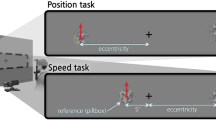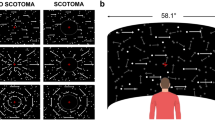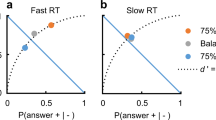Abstract
Human visual speed perception is qualitatively consistent with a Bayesian observer that optimally combines noisy measurements with a prior preference for lower speeds. Quantitative validation of this model, however, is difficult because the precise noise characteristics and prior expectations are unknown. Here, we present an augmented observer model that accounts for the variability of subjective responses in a speed discrimination task. This allowed us to infer the shape of the prior probability as well as the internal noise characteristics directly from psychophysical data. For all subjects, we found that the fitted model provides an accurate description of the data across a wide range of stimulus parameters. The inferred prior distribution shows significantly heavier tails than a Gaussian, and the amplitude of the internal noise is approximately proportional to stimulus speed and depends inversely on stimulus contrast. The framework is general and should prove applicable to other experiments and perceptual modalities.
This is a preview of subscription content, access via your institution
Access options
Subscribe to this journal
Receive 12 print issues and online access
$209.00 per year
only $17.42 per issue
Buy this article
- Purchase on Springer Link
- Instant access to full article PDF
Prices may be subject to local taxes which are calculated during checkout








Similar content being viewed by others
References
Thompson, P. Perceived rate of movement depends on contrast. Vision Res. 22, 377–380 (1982).
Stone, L. & Thompson, P. Human speed perception is contrast dependent. Vision Res. 32, 1535–1549 (1992).
Simoncelli, E. Distributed Analysis and Representation of Visual Motion. Thesis, Massachusetts Institute of Technology (1993).
Weiss, Y., Simoncelli, E. & Adelson, E. Motion illusions as optimal percept. Nat. Neurosci. 5, 598–604 (2002).
Helmholtz, H. Treatise on Physiological Optics (Thoemmes Press, Bristol, UK, 2000). Original publication 1866.
Betsch, B., Einhäuser, W., Körding, K. & König, P. The world from a cat's perspective - statistics of natural videos. Biol. Cybern. 90, 41–50 (2004).
Roth, S. & Black, M. On the spatial statistics of optical flow. International Conference on Computer Vision ICCV, 42–49 (2005).
Dong, D. & Atick, J. Statistics of natural time-varying images. Network: Comput. Neural Syst. 6, 345–358 (1995).
Brenner, N., Bialek, W. & de Ruyter van Steveninck, R. Adaptive rescaling maximizes information transmission. Neuron 26, 695–702 (2000).
Fennema, C. & Thompson, W. Velocity determination in scenes containing several moving objects. Comput. Graph. Image Process. 9, 301–315 (1979).
Horn, B. & Schunck, B. Determining optical flow. Artif. Intell. 17, 185–203 (1981).
Simoncelli, E., Adelson, E. & Heeger, D. Probability distributions of optical flow. IEEE Conference on Computer Vision and Pattern Recognition, 310–313 (IEEE, 1991).
Weber, J. & Malik, J. Robust computation of optical flow in a multi-scale differential framework. Int. J. Comput. Vis. 14, 67–81 (1995).
Weiss, Y. & Fleet, D. Velocity likelihoods in biological and machine vision. in Probabilistic Models of the Brain (Bradford Book, MIT Press, Cambridge, Massachusetts, 2002).
Hürlimann, F., Kiper, D. & Carandini, M. Testing the Bayesian model of perceived speed. Vision Res. 42, 2253–2257 (2002).
Stocker, A.A. Analog VLSI Circuits for the Perception of Visual Motion. (John Wiley & Sons, Chichester, UK, 2006).
Ascher, D. & Grzywacz, N. A Bayesian model for the measurement of visual velocity. Vision Res. 40, 3427–3434 (2000).
Stocker, A. & Simoncelli, E. Constraining a Bayesian model of human visual speed perception. in Advances in Neural Information Processing Systems NIPS Vol. 17 (eds. Saul, L.K., Weiss, Y. & Bottou, L.) (MIT Press, Cambridge, Massachusetts, 2005).
Sclar, G., Maunsell, J. & Lennie, P. Coding of image contrast in central visual pathways of the macaque monkey. Vision Res. 30, 1–10 (1990).
McKee, S. & Nakayama, K. The detection of motion in the peripheral visual field. Vision Res. 24, 25–32 (1984).
McKee, S., Silvermann, G. & Nakayama, K. Precise velocity discrimintation despite random variations in temporal frequency and contrast. Vision Res. 26, 609–619 (1986).
Welch, L. The perception of moving plaids reveals two motion-processing stages. Nature 337, 734–736 (1989).
Stocker, A. Analog integrated 2-D optical flow sensor. Analog Integr. Circuits Signal Process. 46, 121–138 (2006).
Yuille, A. & Grzywacz, N. A computational theory for the perception of coherent visual motion. Nature 333, 71–74 (1988).
Heeger, D. & Simoncelli, E. Model of visual motion sensing. in Spatial Vision in Humans and Robots (Cambridge Univ. Press, Cambridge, UK, 1994).
Knill, D.C. & Richards, W. (eds.). Perception as Bayesian Inference (Cambridge Univ. Press, Cambridge, UK, 1996).
Ernst, M. & Banks, M. Humans integrate visual and haptic information in a statistically optimal fashion. Nature 415, 429ff (2002).
Hillis, J., Ernst, M., Banks, M. & Landy, M. Combining sensory information: mandatory fusion within, but not between senses. Science 298, 1627ff (2002).
Mamassian, P., Landy, M. & Maloney, L. Bayesian modelling of visual perception. in Probabilistic Models of the Brain (MIT Press, Cambridge, Massachusetts, 2002).
Knill, D. & Saunders, J. Do humans optimally integrate stereo and texture information for judgements of surface slant? Vision Res. 43, 2539–2558 (2003).
Alais, D. & Burr, D. The ventriloquist effect results from near-optimal bimodal integration. Curr. Biol. 14, 257–262 (2004).
Körding, K. & Wolpert, D. Bayesian integration in sensorimotor learning. Nature 427, 244–247 (2004).
Yuille, A., Fang, F., Schrater, P. & Kersten, D. Human and ideal observers for detecting image curves. Advances in Neural Information Processing Systems NIPS Vol. 16 (eds. Thrun, S., Saul, L. & Schölkopf, B.) (MIT Press, Cambridge, Massachusetts, 2004).
Thompson, P., Brooks, K. & Hammett, S. Speed can go up as well as down at low contrast: implications for models of motion perception. Vision Res. 46, 782–786 (2006).
Albright, T. Direction and orientation selectivity of neurons in visual area MT of the macaque. J. Neurophysiol. 52, 1106–1130 (1984).
Movshon, J., Adelson, E., Gizzi, M. & Newsome, W. The analysis of moving visual patterns. Exp. Brain Res. Suppl. 11, 117–151 (1985).
Britten, K., Shadlen, M., Newsome, W. & Movshon, A. The analysis of visual motion: a comparions of neuronal and psychophysical performance. J. Neurosci. 12, 4745–4765 (1992).
Priebe, N. & Lisberger, S. Estimating target speed from the population response in visual area MT. J. Neurosci. 24, 1907–1916 (2004).
Pouget, A., Dayan, P. & Zemel, R. Inference and computation with population codes. Annu. Rev. Neurosci. 26, 381–410 (2003).
Shadlen, M., Britten, K., Newsome, W. & Movshon, J. A computational analysis of the relationship between neuronal and behavioral responses to visual motion. J. Neurosci. 16, 1486–1510 (1996).
Nover, H., Anderson, C. & DeAngelis, G. A logarithmic, scale-invariant representation of speed in macaque middle temporal area accounts for speed discrimination performance. J. Neurosci. 25, 10049–10060 (2005).
Simoncelli, E.P. Local analysis of visual motion. in The Visual Neurosciences (MIT Press, Cambridge, Massachusetts, 2003).
Pack, C., Hunter, J. & Born, R. Contrast dependence of suppressive influences in cortical area MT of alert macaque. J. Neurophysiol. 93, 1809–1815 (2005).
Stocker, A. & Simoncelli, E. Sensory adaptation within a Bayesian framework for perception. in Advances in Neural Information Processing Systems NIPS Vol. 18 (MIT Press, Vancouver, 2006).
Green, D. & Swets, J. Signal Detection Theory and Psychophysics (Wiley, New York, 1966).
Wickens, T.D. Elementary Signal Detection Theory (Oxford University Press, Oxford, 2001).
Acknowledgements
The authors thank all subjects for participation in the psychophysical experiments. Thanks to J.A. Movshon and D. Heeger for helpful comments on the manuscript. This work was primarily funded by the Howard Hughes Medical Institute.
Author information
Authors and Affiliations
Corresponding author
Ethics declarations
Competing interests
The authors declare no competing financial interests.
Supplementary information
Supplementary Fig. 1
Raw psychometric data collected from subject 1 and 2 under all tested conditions. (PDF 1756 kb)
Rights and permissions
About this article
Cite this article
Stocker, A., Simoncelli, E. Noise characteristics and prior expectations in human visual speed perception. Nat Neurosci 9, 578–585 (2006). https://doi.org/10.1038/nn1669
Received:
Accepted:
Published:
Issue Date:
DOI: https://doi.org/10.1038/nn1669
This article is cited by
-
A unifying theory explains seemingly contradictory biases in perceptual estimation
Nature Neuroscience (2024)
-
Representing stimulus motion with waves in adaptive neural fields
Journal of Computational Neuroscience (2024)
-
Motion perception in touch: resolving contradictory findings by varying probabilities of different trial types
Psychological Research (2024)
-
Tapping on a target: dealing with uncertainty about its position and motion
Experimental Brain Research (2023)
-
Effect of optic flow on spatial updating: insight from an immersive virtual reality study
Experimental Brain Research (2023)



